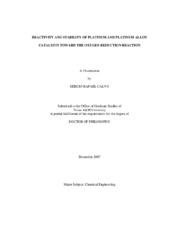| dc.description.abstract | Density functional theory (DFT) is used to study the reactivity of Pt and Pt-M
(M: Pd, Co, Ni, V, and Rh) alloy catalysts towards the oxygen reduction reaction (ORR)
as a function of the alloy overall composition and surface atomic distribution and
compared to that on pure Pt surfaces. Reactivity is evaluated on the basis of the
adsorption strength of oxygenated compounds which are intermediate species of the
four-electron oxygen reduction reaction, separating the effect of the first electron-proton
transfer from that of the three last electron-proton transfer steps.
It is found that most homogeneous distribution PtxM catalysts
thermodynamically favor the dissociation of adsorbed OOH in comparison with pure
Platinum and adsorb strongly O and OH due to the strong oxyphilicity of the M
elements. On the other hand, in all cases skin Platinum surfaces catalysts do not favor
the dissociation of adsorbed OOH and do favor the reduction of M-O and M-OH with
respect to Platinum. Considering the overall pathway of the reactions to catalyze the
ORR most of the skin Platinum monolayer catalysts provide more negative free energy
changes and should behave at least in a similar way than Platinum in following order:
Pt3V (skin Pt) > Pt3Co (skin Pt) > Pt3Ni (skin Pt) > Pt > PtPd (skin) > Pt4Rh (skin Pt) >
PtPd3 (skin ). In all cases, the reactivity is shown to be not only sensitive to the overall
composition of the catalyst, but most importantly to the surface atomic distribution.
Proposed electrochemical dissolution reactions of the catalyst atoms are also
analyzed for the ORR catalysts, by computing the free energy changes of Platinum and
bimetallic Pt-X (X: Co, Pd, Ni, and Rh) catalysts. It is found that Platinum is
thermodynamically more stable than Pt-alloys in Pt3Co, Pt3Pd, Pt3Ni and Pt4Rh. | en |


